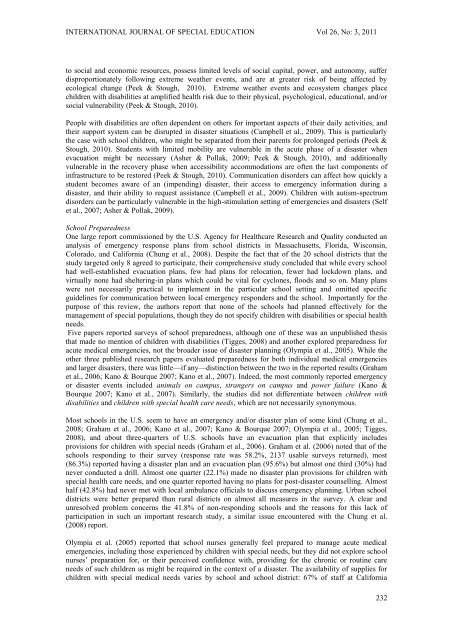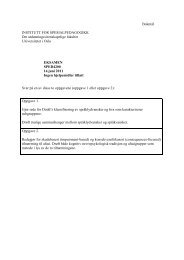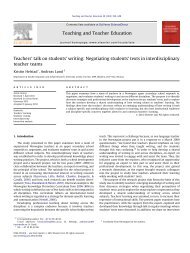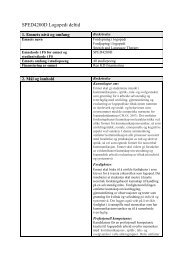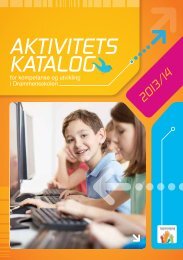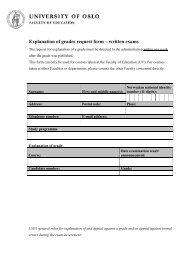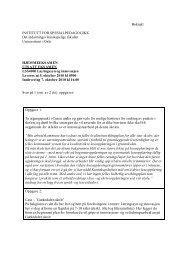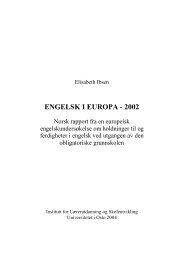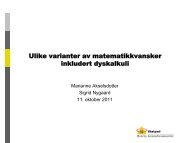International Journal Special Education
International Journal Special Education
International Journal Special Education
Create successful ePaper yourself
Turn your PDF publications into a flip-book with our unique Google optimized e-Paper software.
INTERNATIONAL JOURNAL OF SPECIAL EDUCATION Vol 26, No: 3, 2011to social and economic resources, possess limited levels of social capital, power, and autonomy, sufferdisproportionately following extreme weather events, and are at greater risk of being affected byecological change (Peek & Stough, 2010). Extreme weather events and ecosystem changes placechildren with disabilities at amplified health risk due to their physical, psychological, educational, and/orsocial vulnerability (Peek & Stough, 2010).People with disabilities are often dependent on others for important aspects of their daily activities, andtheir support system can be disrupted in disaster situations (Campbell et al., 2009). This is particularlythe case with school children, who might be separated from their parents for prolonged periods (Peek &Stough, 2010). Students with limited mobility are vulnerable in the acute phase of a disaster whenevacuation might be necessary (Asher & Pollak, 2009; Peek & Stough, 2010), and additionallyvulnerable in the recovery phase when accessibility accommodations are often the last components ofinfrastructure to be restored (Peek & Stough, 2010). Communication disorders can affect how quickly astudent becomes aware of an (impending) disaster, their access to emergency information during adisaster, and their ability to request assistance (Campbell et al., 2009). Children with autism-spectrumdisorders can be particularly vulnerable in the high-stimulation setting of emergencies and disasters (Selfet al., 2007; Asher & Pollak, 2009).School PreparednessOne large report commissioned by the U.S. Agency for Healthcare Research and Quality conducted ananalysis of emergency response plans from school districts in Massachusetts, Florida, Wisconsin,Colorado, and California (Chung et al., 2008). Despite the fact that of the 20 school districts that thestudy targeted only 8 agreed to participate, their comprehensive study concluded that while every schoolhad well-established evacuation plans, few had plans for relocation, fewer had lockdown plans, andvirtually none had sheltering-in plans which could be vital for cyclones, floods and so on. Many planswere not necessarily practical to implement in the particular school setting and omitted specificguidelines for communication between local emergency responders and the school. Importantly for thepurpose of this review, the authors report that none of the schools had planned effectively for themanagement of special populations, though they do not specify children with disabilities or special healthneeds.Five papers reported surveys of school preparedness, although one of these was an unpublished thesisthat made no mention of children with disabilities (Tigges, 2008) and another explored preparedness foracute medical emergencies, not the broader issue of disaster planning (Olympia et al., 2005). While theother three published research papers evaluated preparedness for both individual medical emergenciesand larger disasters, there was little—if any—distinction between the two in the reported results (Grahamet al., 2006; Kano & Bourque 2007; Kano et al., 2007). Indeed, the most commonly reported emergencyor disaster events included animals on campus, strangers on campus and power failure (Kano &Bourque 2007; Kano et al., 2007). Similarly, the studies did not differentiate between children withdisabilities and children with special health care needs, which are not necessarily synonymous.Most schools in the U.S. seem to have an emergency and/or disaster plan of some kind (Chung et al.,2008; Graham et al., 2006; Kano et al., 2007; Kano & Bourque 2007; Olympia et al., 2005; Tigges,2008), and about three-quarters of U.S. schools have an evacuation plan that explicitly includesprovisions for children with special needs (Graham et al., 2006). Graham et al. (2006) noted that of theschools responding to their survey (response rate was 58.2%, 2137 usable surveys returned), most(86.3%) reported having a disaster plan and an evacuation plan (95.6%) but almost one third (30%) hadnever conducted a drill. Almost one quarter (22.1%) made no disaster plan provisions for children withspecial health care needs, and one quarter reported having no plans for post-disaster counselling. Almosthalf (42.8%) had never met with local ambulance officials to discuss emergency planning. Urban schooldistricts were better prepared than rural districts on almost all measures in the survey. A clear andunresolved problem concerns the 41.8% of non-responding schools and the reasons for this lack ofparticipation in such an important research study, a similar issue encountered with the Chung et al.(2008) report.Olympia et al. (2005) reported that school nurses generally feel prepared to manage acute medicalemergencies, including those experienced by children with special needs, but they did not explore schoolnurses’ preparation for, or their perceived confidence with, providing for the chronic or routine careneeds of such children as might be required in the context of a disaster. The availability of supplies forchildren with special medical needs varies by school and school district: 67% of staff at California232


